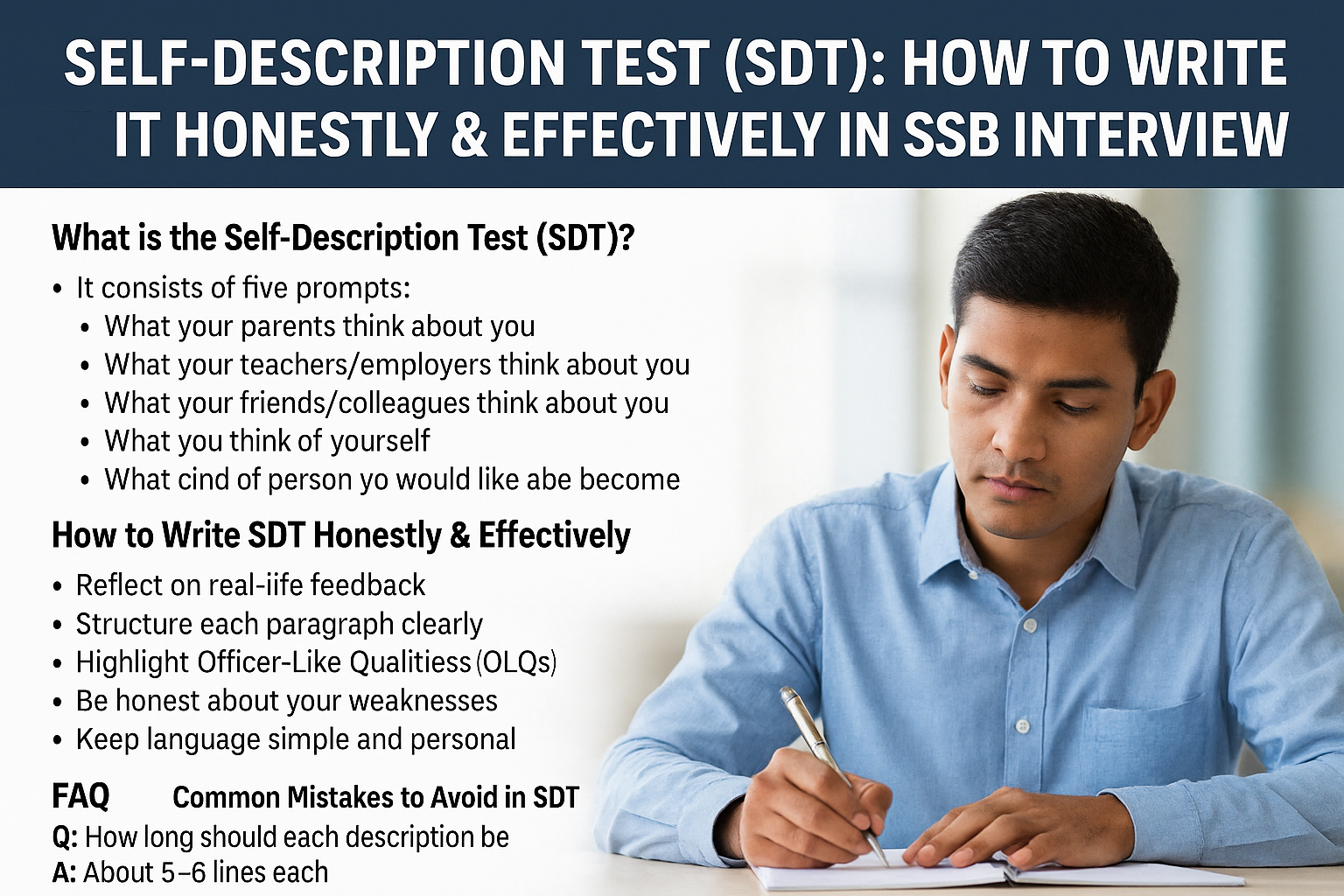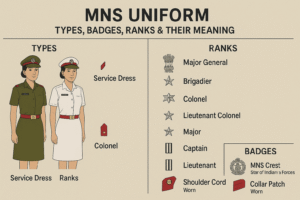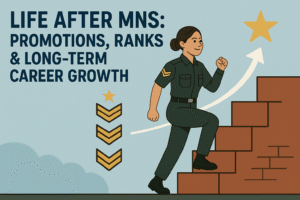The Self-Description Test (SDT) is one of the most revealing psychological assessments in the SSB Interview process. It is conducted to gain deep insights into your personality, self-awareness, interpersonal behavior, and Officer Like Qualities (OLQs). Unlike other tests such as TAT or WAT, the SDT gives you the chance to directly describe yourself based on how others perceive you—and how you perceive yourself.
In this comprehensive SEO-friendly article, we’ll guide you through what the SDT is, why it’s important, and how to write honest and effective SDTs that reflect your true personality while aligning with the values expected in a future officer.
What is the Self-Description Test (SDT) in SSB?
The Self-Description Test is the final part of the Psychological Testing in the SSB interview. You are given 5 specific prompts, and you must write your response to each one within 15 minutes total.
The 5 prompts are:
What your parents think about you
What your teachers/employers think about you
What your friends/colleagues think about you
What you think of yourself
What kind of person you would like to become
Each description is expected to be factual, concise, and truthful, reflecting both your strengths and areas of improvement.
Objective of SDT in SSB
The SDT is used by assessors to:
Understand your self-awareness
Evaluate your social adaptability and interpersonal relations
Judge your honesty and introspection
Assess if you possess balanced and realistic self-perception
Cross-check your responses from TAT, WAT, and SRT for consistency
How to Write SDT Honestly & Effectively
1. Reflect on Real-Life Feedback
Before writing, take time to genuinely reflect on what your parents, friends, teachers, and employers have said about you. Be honest with both praise and criticism. Don’t write what you think assessors want to hear—write what is true.
Tip: Ask people close to you for their feedback. Record their comments and analyze the recurring traits.
2. Structure Each Paragraph Clearly
Each of the five sections should be structured with:
1–2 strengths
1 minor weakness (preferably one you’re working on)
A concluding line showing growth or maturity
Example:
My parents consider me responsible and sincere. They often praise my ability to manage time and stay calm during difficult situations. However, they feel I sometimes overthink before taking action. They encourage me to be more decisive. Overall, they are proud of my discipline and dedication.
3. Highlight Officer-Like Qualities (OLQs)
Your SDT should naturally reflect OLQs such as:
Responsibility
Initiative
Team spirit
Leadership
Effective intelligence
Self-confidence
Social adaptability
Avoid directly stating “I have OLQs”—instead, demonstrate them subtly through personality traits and real-life behaviors.
4. Be Honest About Your Weaknesses
No one is perfect. Assessors look for self-aware individuals who can acknowledge their flaws and show efforts to improve. Avoid fake weaknesses like “I work too hard.” Instead, show genuine areas you’re improving.
Example:
My friends say I’m dependable and always available to help. Some of them feel I need to open up more socially. I’m working on being more expressive and confident in group settings.
5. Keep Language Simple and Personal
Avoid flowery or memorized language. Your tone should be:
Genuine
Simple
Reflective
Positive in outlook
Avoid using big words or fancy expressions. This is not an English test—it’s a personality reflection test.
6. Practice Writing and Get Feedback
Write multiple drafts of your SDT and ask mentors, friends, or SSB trainers to review them. Make sure your responses are:
Realistic
Balanced
Not contradictory to your actions in TAT/WAT/SRT
7. Align the “Ideal Person” Paragraph with Army/Navy/Air Force Values
In the fifth paragraph—“What kind of person you want to become”—describe a realistic, growth-oriented vision that aligns with military values:
Example:
I aspire to become a calm, courageous, and disciplined individual who can lead by example. I want to develop better physical endurance and mental resilience. I am working every day toward becoming someone who can serve the nation with honor.
Sample SDT Response Format (Short)
1. What my parents think about me:
My parents consider me disciplined, sincere, and focused. They trust me with responsibilities. They feel I need to improve my communication skills and socialize more.
2. What my teachers think about me:
Teachers see me as hardworking, punctual, and cooperative. They’ve appreciated my consistency in academics. They advise me to take more leadership roles in class.
3. What my friends think about me:
Friends say I’m trustworthy and a good listener. They rely on me during difficult times. Some feel I take life too seriously and encourage me to be more relaxed.
4. What I think about myself:
I see myself as sincere, thoughtful, and goal-oriented. I enjoy learning new things and helping others. I’m working to be more confident in public speaking.
5. What kind of person I want to become:
I want to become a dependable and decisive person who can contribute to the nation. I aim to build my mental strength, leadership, and emotional intelligence to serve in the armed forces.
Common Mistakes to Avoid in SDT
Writing exaggerated or idealized traits
Copying responses from the internet
Being overly negative or self-critical
Ignoring weaknesses or pretending to be perfect
Using fancy language or trying to impress
Final Thoughts
The Self-Description Test is your chance to show the real you—your values, character, and growth mindset. If you prepare honestly, reflect deeply, and align your personality with Officer Like Qualities, you’ll not only ace the SDT but also build stronger impressions in the overall SSB process.
Remember, SSB is not looking for perfect candidates—they are looking for trainable, sincere, and honest individuals who can become effective leaders.
FAQ: Self-Description Test (SDT) in SSB
Q1. How long should each SDT paragraph be?
Each paragraph should be around 5–6 lines. Focus on quality, not quantity.
Q2. Can I write only positive traits?
No. Include minor, realistic weaknesses and mention efforts to improve them.
Q3. Will assessors compare my SDT with TAT/WAT/SRT?
Yes. Consistency across all psych tests is very important.
Q4. Is it okay to write the same SDT in every attempt?
Not exactly. Your SDT should evolve based on real growth. Keep updating it as you improve.
Q5. Should I memorize the SDT?
You can prepare and practice it, but don’t mug it up. Write in your own words during the test.
Q6. How can I improve my SDT?
Take honest feedback from parents, friends, and mentors. Practice writing and revise after expert review.






